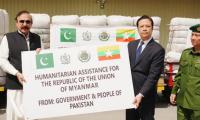The writer is a freelance contributor.
The gloom cast upon the global economy by Covid-19 did not spare Pakistan. Already on the downward trajectory even before the pandemic struck, Pakistan’s economy grinded to a halt as the negative fallouts, and strict lockdown, resulted in negative growth for the first time in more than half a century.
However, of late, there have been claims of economic recovery that have been making the rounds. These primarily come through statistics on a few chosen sectors, tweeted frequently by various government ministers. For example, on October 26, Hammad Azhar mentioned stock market rally, appreciation of domestic currency, growth in sectors like cement, automobiles, construction, fertilizer, tax revenue figures and current account (CA) surplus as indicators that Pakistan’s economy is gaining momentum. A few days later, Abdur Razaq Dawood tweeted that Pakistan’s October exports were above $2 billion, a continuous trend since July, and a sure sign of economic recovery. And, of course, there is the oft-repeated number on remittances, which have recorded an upward trajectory during this year.
I have two contentions to make regarding the government narrative: one, basing the ‘recovery’ narrative on a few chosen statistics does not do justice to the aggregate economic picture. For that, we need to dig deeper into the forces and factors that are shaping this recovery of sorts. Second, such periodic episodes showing positive economic indicators are nothing new. More worryingly, these episodes have rarely transformed into sustainable, higher economic growth.
Let’s proceed with parsing the numbers upon which the official recovery narrative is based. The stock market (PSX) number is arguably the biggest chink in the official armor. Its rise and fall is so sudden that quoting it as a barometer of economic wellbeing is questionable, at least in Pakistan. As an example, on November 2, the stock market lost close to a thousand points in a single day, a few days after it went through a similar losing spree (note: none of the over-zealous ministers or spokesmen tweeted that story). I can cite other factors (small investor base with concentration in only three cities, for eg) to elucidate that the PSX is a small part of the aggregate picture, worth not relying upon to reflect aggregate activity.
Rejoicing over CA surplus misses the point that the price of attaining this is forgone economic growth. Pakistan’s economy is structured in a manner that higher growth begets higher imports, and vice versa. Although high tariffs are the usual norm in bringing down the CA deficit (‘the demand compression’ aspect), as also employed by the present government, former attempts rarely turned the CA to surplus. What propelled it to surplus was the ‘domestic income shock’, as severely curtailed economic activity led to precipitous drops in income, thus acting in unison with higher tariffs (and rupee’s depreciation) to perpetuate an economy wide demand shock that led to a substantial drop in demand for imports. So, on the one hand, we have a CA surplus whose main advantage is that it will save us a bit of foreign exchange. But on the other, this saving has come at the cost of higher unemployment, higher poverty and greater inequality. I would be more worried about the latter.
The rise in exports seems a bit of a puzzle. At a time when Covid-19 has struck Pakistan’s major destinations hard, how did Pakistan manage to attain steadiness or growth in its exports? A probable answer lies within the export numbers, and the substantial demand appreciation in health services. Almost 60 percent of Pakistan’s exports are made up of only one sector: textiles and its related products. The July to September 2020 data on exports is no different in this regard. For a sector that comprises almost 60 percent of our exports, even a small increase in it would make the overall numbers look pretty, especially in the time of falling imports.
What has helped Pakistan keep its textile exports steady and growing is the fact that as almost every sector of the global economy has taken a tumble, the demand for health services has witnessed a precipitous growth. In this particular category, raw material like cotton and finished products like bed sheets, knitted clothing, etc, are in great demand (for hospitals, nursing homes, etc.). Quite remarkably, of the total export earnings through textiles, 97 percent ($2 billion, 934 million) owes to earnings from these raw and finished products!
Simply put, export performance has little, if anything, to do with the government and its policies, but owes mostly to global misfortune that is working to our advantage. It is reminiscent of the precipitous rise in Pakistan’s exports in the early 50s, courtesy of the Korean War as a result of which demand for cotton skyrocketed.
While looking at the rupee’s appreciation against the dollar, it is important not to lose sight of the impact that the dollar has been losing value against all the leading currencies since April 2020 (reflected through Dollar Index). So, it’s a case of asking whether the rupee is gaining strength on the back of domestic economic performance, or if it is simply the case that the dollar is losing value world over? Also, let’s not forget that Pakistan received foreign funding (loans) above $2 billion in the month of October, such inflows always tending to prop up the rupee.
The rebound in the cement and construction sectors are solely due to the huge subsidized packages offered for the construction sector by the government, complemented by billions of rupees made available for brick and mortar projects through the PSDP. Quite naturally, the demand had to jump. As far as remittances are concerned, is it not a puzzle that at a time when Pakistani labour finds it exceedingly difficult to hold onto their jobs (with a substantial portion losing theirs, especially in the Gulf areas), it will start sending back more remittances? The puzzle will probably be answered by considering the formidable pressure being exerted upon Pakistan by the FATF to block illicit channels of remittance flows. Arguably, it is the closure of illegal channels of sending back remittances that has caused the increase rather than an increase in the income of the Pakistani diaspora.
We finally come to the tax revenue performance. More important than what was collected is the questions of components of the collection. In all probability, its indirect taxes (petroleum levy, withholding taxes, etc) that are the larger components of the sum collected, something not to gloat about since they are regressive in nature. In times when poverty and inequality are on the rise, regressive taxation will give further vent to these phenomena.
While the official narrative is focused upon the positives, there are worrying signs for the economy and its long-held structural issues still remain. For eg, the private sector’s credit off-take has remained negative (even after a large drop in the cost of loans). That is worrisome since the federal and provincial governments fill this void, at the cost of productivity and efficiency. The power sector’s circular debt now stands at a whopping Rs2.2 trillion. ‘Commodity operations’ debt (for buying commodities like wheat) is now above Rs800 billion. The sugar and wheat scandals, as well as the serious gas deficiency to be encountered in the winter, are just some of the signs that reflect the persistence of the structural deficiencies that have plagued our economy for long. Unfortunately, there is no concrete plan till now to counter these issues.
Now, lest the above be taken as a charge sheet against the government, let me clarify that the content stated above was merely an attempt to debate the narrative propelled by officialdom. One cannot but applaud, for example, the way the federal and provincial governments have handled the corona challenge till now. Do permit me, though, to say that the hoopla perpetrated by the government economic team reminds me of Alan Greenspan’s famous ‘irrational exuberance’ speech. Pakistan economy’s structural deficiencies still persist, and it is highly unlikely that short-term gains in a few sectors can lead to the much-wanted long-term gains centered on sustained economic growth.
The jubilations can wait a bit.
The writer is a research fellow at PIDE.
Email: shahid.mohmand@gmail.com
Twitter: ShahidMohmand79
This demand has fueled rapid growth deposit base of Islamic Banks and Islamic Windows operated by conventional banks
But Punjab Agriculture Food and Drug Authority building near Thokar Niazbeg on Multan Road stands out
Macron has been particularly vocal in their criticism, asserting that withholding arms from Kyiv plays directly into...
As PPP governs province, Bilawal Bhutto Zardari holds strategic position to address both violence and its underlying...
Critics argue that strategy is vague, but closer look indicates strategic alignment with global trends and national...
To defeat it, we must distrust bot-driven narratives, to defeat it, we must verify sources before believing or sharing







